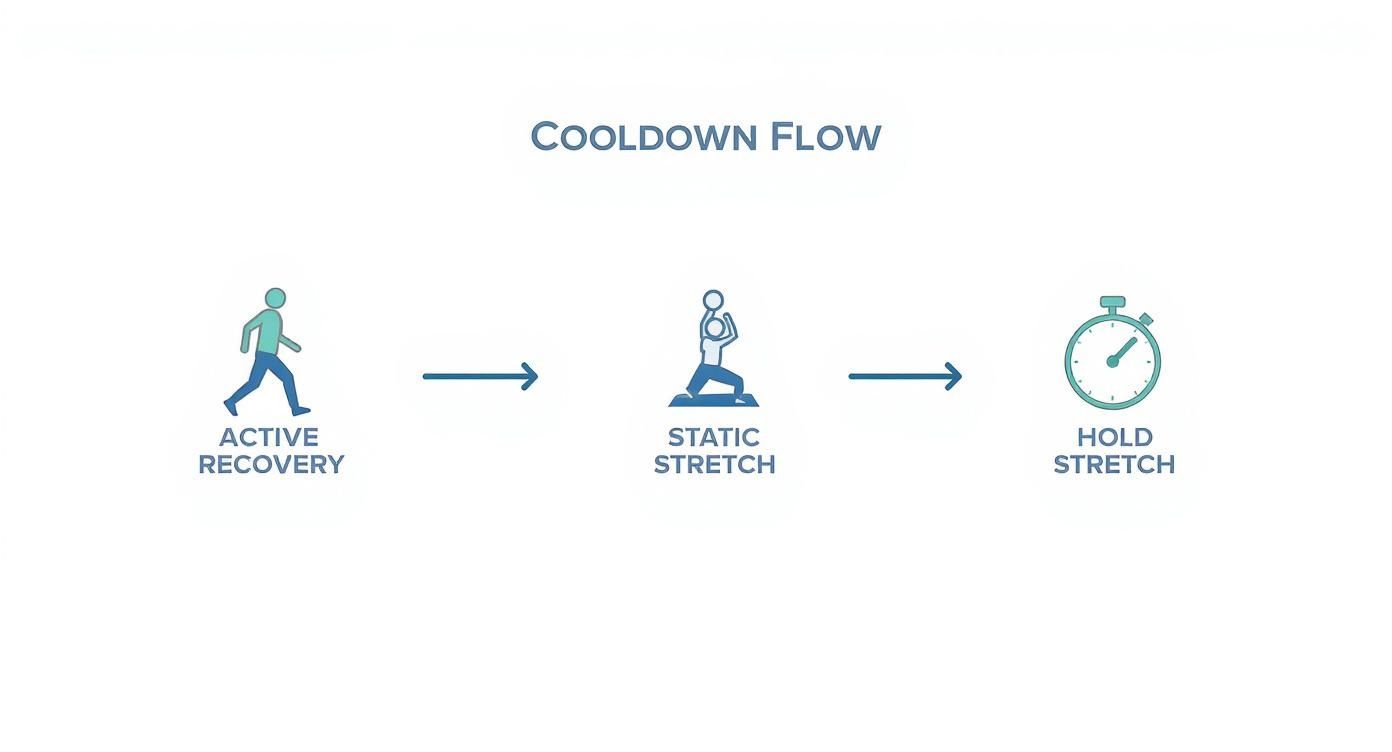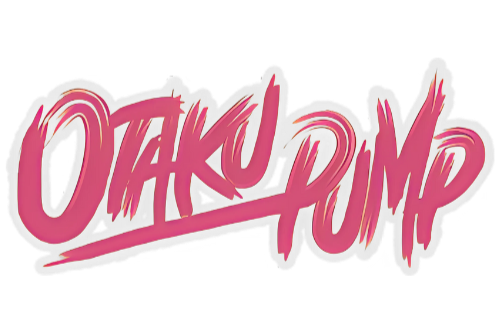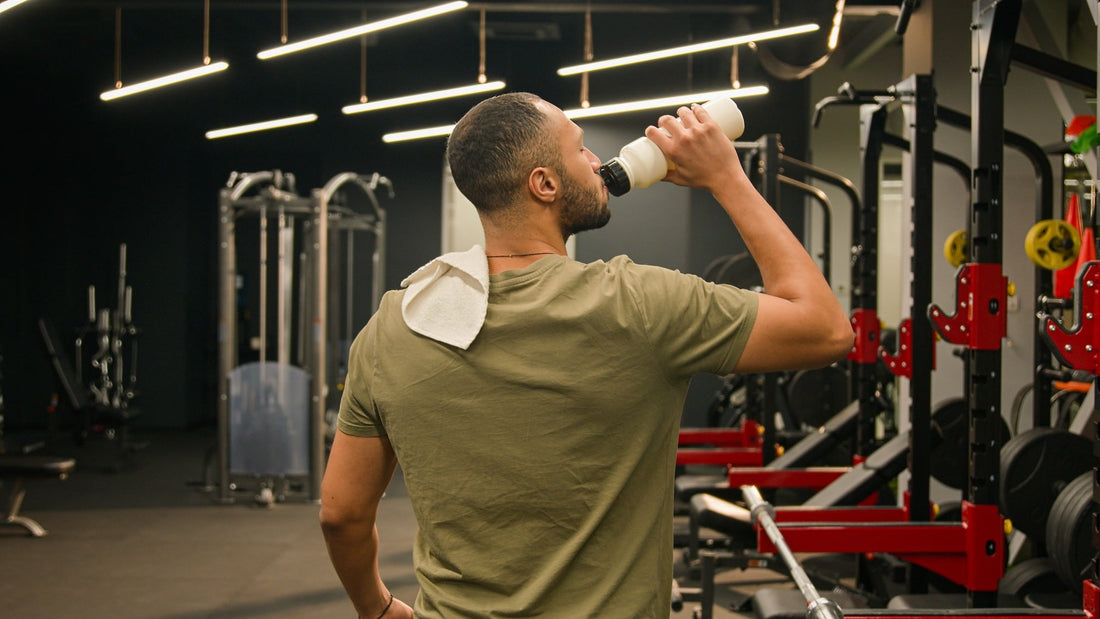Ever finished an intense workout, feeling like you’ve gone Super Saiyan, and just wanted to crash on the couch? I get it. But slamming on the brakes right after pushing your body to its limit is one of the biggest mistakes you can make.
Think of your cooldown not as the end of your session, but as the start of your recovery. It's that critical bridge period your body needs to shift from high gear back to a resting state.
Why Your Cooldown Is Just as Important as Your Workout
When you stop dead after a tough workout, your heart rate and blood pressure can plummet. That sudden drop is what leaves you feeling dizzy, lightheaded, or even nauseous. A proper cooldown helps bring everything back down to earth gradually, preventing that unpleasant post-workout crash.
It's also your secret weapon against the dreaded DOMS (Delayed Onset Muscle Soreness). You know the feeling—that deep ache and stiffness that kicks in 12 to 48 hours after you've really challenged yourself. A solid cooldown helps flush out the metabolic waste that builds up in your muscles, which can seriously cut down on how sore you feel the next day.
Kicking Off the Muscle Repair Process
This transition isn't just about feeling better in the short term; it's about kickstarting the muscle repair process. When you cool down, you're essentially telling your body, "Okay, the hard work is done. Time to rebuild."
This has a few massive payoffs:
- Faster Recovery: You're giving your body a head start on repairs, meaning you bounce back quicker and are ready to go for your next session.
- Better Flexibility: Stretching while your muscles are still warm and pliable is the best way to improve your range of motion over time.
- Injury Prevention: A gradual recovery puts less strain on your heart and helps prevent future injuries by keeping your muscles and joints healthy.
To get a better sense of the impact, here's a look at the immediate and long-term differences between dedicating time to a cooldown versus skipping it entirely.
Cooldown vs No Cooldown: A Quick Comparison
| Action | Immediate Effect | Long-Term Impact |
|---|---|---|
| Cooling Down | Heart rate lowers safely, dizziness is prevented, and muscle relaxation begins. | Improved flexibility, reduced risk of injury, and consistently faster recovery times. |
| Skipping It | Abrupt drop in heart rate and blood pressure, potential for dizziness, and trapped metabolic waste. | Chronic muscle tightness, increased chance of strains, and prolonged soreness after workouts. |
As you can see, those few extra minutes make a huge difference.
By dedicating just 10-15 minutes to this crucial step, you're ensuring all that effort you just put in actually translates into real gains. Some athletes even explore things like the benefits of using a sauna after workout for recovery to take their relaxation and muscle repair to the next level. The bottom line? Don't cheat your recovery.
The Active Recovery Phase: How to Wind Down Like a Pro
That first instinct to just drop to the floor after a brutal workout? Ignore it. Your cooldown shouldn't start with a dead stop—it should start by simply slowing down.
This is what we call active recovery, and it’s all about gradually easing your body out of high gear instead of slamming on the brakes. Think of it as a controlled descent for your heart rate and breathing after you've pushed your body to its limits.
Why Slowing Down Is a Game-Changer
It all comes down to blood flow. When you stop cold, blood can pool in your arms and legs, sometimes making you feel lightheaded or dizzy. Keeping your body moving, even gently, helps your circulation shuttle blood back to your heart.
This sustained blood flow is your body's personal cleanup crew. It helps flush out metabolic waste, like lactic acid, that builds up in your muscles during an intense session.
By keeping the blood moving, you're actively delivering fresh oxygen and nutrients to tired muscles while carrying away all that junk. This one simple habit makes a massive difference in how stiff and sore you feel the next day.
How to Do Active Recovery Right
The key here is simple: match the movement to the workout. You want to use the same muscles you just hammered, but at a super low intensity. This ensures you’re clearing out all that metabolic gunk from the right places.
Here’s what that looks like in the real world:
- After a Heavy Lifting Day: Just finished a monster leg day? Don’t sit down. Instead, walk it out for a few minutes and then do 5-10 minutes of slow, unweighted bodyweight squats or hop on a stationary bike with zero resistance.
- After a High-Intensity Run: Whatever you do, don't just stop at the finish line. Ease into a slow jog for a couple of minutes, then transition to a brisk walk for another five.
- After a Full-Body Circuit: Light rowing, slow arm circles, or just a steady walk on the treadmill are all fantastic ways to bring your entire system back down to earth.
This gentle transition is one of the most powerful things you can do to fight off muscle soreness. If you want to really get ahead of the game, check out our guide on how to prevent muscle soreness for more advanced tips. A smart cooldown today means you'll be ready to crush it again tomorrow.
Mastering Stretches for Flexibility and Muscle Repair
After you've brought your heart rate down with some light active recovery, it’s time for what most of us think of when we hear "cooldown": static stretching. This isn't just about mindlessly touching your toes. It’s a focused practice designed to lengthen your muscles, melt away tension, and kickstart your body's repair process.
Stretching is most effective—and safest—when your muscles are already warm and pliable from your workout. Trying to stretch cold muscles is like trying to stretch a cold rubber band; it’s not very effective and you risk causing an injury. That's why active recovery always comes first. It perfectly sets the stage for a deep, productive stretch session.
This simple infographic gives you a great visual for the ideal cooldown sequence.

As you can see, the flow is key. You move from gentle movement into those deep, sustained holds. That’s how you get the real benefits.
Key Stretches for Major Muscle Groups
To get the most out of your time, focus on stretching the specific muscle groups you just worked. Don't rush it. The goal is to hold each stretch for 30 to 60 seconds without any bouncing. Bouncing, sometimes called ballistic stretching, can actually cause tiny tears in the muscle fibers, which is the exact opposite of what we're trying to achieve.
Instead, just breathe deeply and gently ease into each position.
- Hamstring Stretch: Sit down, extend one leg straight, and bend the other. Hinge forward from your hips over the straight leg until you feel that nice, gentle pull.
- Quad Stretch: Stand up and hold onto a wall or chair for balance. Grab one ankle and gently guide your heel toward your glute, keeping your knees close together.
- Chest Stretch: Find a doorway and place your forearms on the frame, with your elbows just a bit below your shoulders. Take a small step forward until you feel a good stretch across your chest.
- Upper Back Stretch (Child's Pose): This one feels amazing. Kneel on the floor, sit back on your heels, and then fold forward, reaching your arms out in front of you. You'll feel a great release in your lats and shoulders.
One of the biggest mistakes I see people make is holding their breath while they stretch. Deep, steady breathing is your best friend here. It tells your nervous system to chill out, allowing your muscles to relax and lengthen even more.
To make it even easier, you can match your cooldown stretches directly to the workout you just completed.
Targeted Static Stretches for Your Workout
Match your workout with the most effective cooldown stretches to maximize recovery and flexibility.
| Workout Type | Primary Muscles Worked | Recommended Cooldown Stretches |
|---|---|---|
| Running/Cycling | Quads, Hamstrings, Glutes, Calves | Quad Stretch, Hamstring Stretch, Pigeon Pose, Calf Stretch |
| Upper Body Strength | Chest, Back, Shoulders, Biceps | Doorway Chest Stretch, Child's Pose, Cross-Body Shoulder Stretch |
| Full Body/HIIT | All major muscle groups | Child's Pose, Quad Stretch, Hamstring Stretch, Chest Stretch |
| Yoga/Pilates | Core, Back, Hips | Cat-Cow Stretch, Supine Twist, Cobra Pose |
Tailoring your stretches this way ensures you're giving the most attention to the muscles that need it most, which can seriously speed up your recovery.
Why Holding the Stretch Matters
That 30-60 second hold is where the magic really happens. It gives your muscle spindles—tiny sensory receptors inside your muscles—enough time to get comfortable with the new length. This process is called stress relaxation, and it helps reset your muscle's normal resting length, leading to real, lasting improvements in your flexibility.
Think of it this way: a quick five-second stretch is like a suggestion. A sustained 30-second hold is a clear command for your muscles to relax and lengthen. By making static stretching a non-negotiable part of your routine, you're not just fighting off soreness—you're making a long-term investment in your mobility and athletic performance.
How Nutrition And Hydration Supercharge Your Cooldown
Your cooldown doesn’t wrap up the moment you step off the mat. It continues in the kitchen, where each bite you take lays down the foundation for stronger, healthier muscle tissue.
Rehydration is non-negotiable right after your last rep. Sweat doesn’t just carry away water—it steals electrolytes essential for smooth muscle contractions. If you let hydration slip, you’ll feel it in every ache and stiff joint, so keep that water bottle handy and sip consistently.
Refueling For Muscle Repair And Energy
Your body’s hungry for two main macronutrients after intense exercise:
- Carbohydrates to refill depleted glycogen reserves.
- Protein to deliver amino acids that stitch up microscopic muscle fibers.
The legendary “anabolic window” has loosened up: timing helps, but your total daily intake drives recovery. Still, a quick dose of quality protein post-workout can kickstart repair. Dive into the latest findings on nutrient timing for deeper insights.
Smart pre-workout fuels do more than boost your performance—they set the stage for your cooldown. A well-formulated pre-workout like Otaku Pump not only fires you up with energy but can also contain ingredients that prime muscle tissue to absorb nutrients efficiently post-session. If you want to fine-tune your supplement strategy, check out the best supplements for muscle recovery.
Ready to plan your post-gym meals? Explore our full list of the best post-workout recovery foods for real-world meal ideas that will have you firing on all cylinders come next session.
Amp Up Your Recovery with Advanced Techniques
If you're really pushing your limits in the gym, a few quick stretches just won't cut it. To truly maximize your gains and bounce back faster, you need to get a little more strategic with your cooldown. This means digging into methods that specifically target muscle repair and stamp out inflammation before it starts.
One of the best tools you can have in your arsenal is a foam roller. This technique, also known as self-myofascial release, is basically a deep-tissue massage you can do yourself. By rolling out tight spots, you're breaking up adhesions (or "knots") and boosting blood flow right where you need it. Better circulation means nutrients get delivered to your muscles faster.
Speaking of nutrients, what you put in your body is just as crucial. After a tough session, your muscles are screaming for building blocks to repair themselves. If you're curious about the science behind it, dive into our guide on amino acids for muscle recovery.
Professional Recovery Methods Worth a Look
Beyond what you can do at home or in the gym, there's a whole world of pro-level recovery services popping up. This isn't just a fad; the global fitness recovery market is expected to rocket from about $8.2 billion in 2025 to nearly $24.5 billion by 2035. That kind of growth tells you this stuff works.
A couple of the most popular options include:
- Cryotherapy: This involves stepping into a chamber with super-cold air for a few minutes. The extreme cold helps dramatically reduce inflammation and can make a huge difference in next-day soreness.
- Compression Therapy: Think of high-tech inflatable sleeves for your arms or legs. They rhythmically squeeze and release, which helps flush out lactic acid and other metabolic waste while improving circulation.
These services used to be reserved for elite athletes, but they're becoming way more common and accessible. If you're serious about your performance, they're definitely worth checking out.
Your Top Cooldown Questions, Answered
You’ve got the routine down, but let's be real—questions always come up when you're trying to get things just right. When it comes to the perfect post-workout cooldown, a lot of conflicting advice floats around.
Let's cut through the noise and tackle some of the biggest questions I hear all the time.
How Long Should My Cooldown Actually Be?
This isn't a one-size-fits-all answer. The length of your cooldown should match the intensity of your training session. The harder you went, the more time your body needs to gear down.
- Going all out? (Heavy lifts, HIIT, long runs): You’ll want to dedicate a good 15-20 minutes to your cooldown. This gives your heart rate a chance to come down slowly and helps your body start clearing out all that metabolic waste.
- Just a regular workout? (Light jogging, standard gym session): A solid 10-15 minute cooldown will do the trick.
Can I Just Skip to the Stretching Part?
I get it, you're tired and just want to get to the relaxing part. But jumping straight into static stretching after a tough workout is a rookie mistake. Your muscles stretch best when they're still warm and blood is flowing.
Active recovery is what keeps them in that prime state, while also kicking off the cleanup process.
Here's how I think about it: Active recovery is like tidying up the room after a party. Static stretching is like rearranging the furniture to make it more comfortable. You can’t really do the second part well until you’ve done the first.
What’s the Real Difference Between a Warm-Up and a Cooldown?
This is a huge point of confusion, but the difference is simple and absolutely critical.
A warm-up is all about getting your body ready for action. You're gradually ramping up your heart rate, getting your core temperature up, and sending blood to your muscles. It’s all about dynamic movements that look a lot like the workout you're about to crush.
A cooldown, on the other hand, is the complete opposite. It’s designed to bring your body back to a state of rest by gradually bringing down all those same metrics. This is where you focus on gentle movements and static holds.
Think of it this way: one prepares you for battle, the other helps you recover from it.
Ready to power up your workouts and make every recovery count? Fuel your next session with Otaku Pump and feel the difference a premium, anime-themed pre-workout makes. Check out our formulas and find your power level today!




